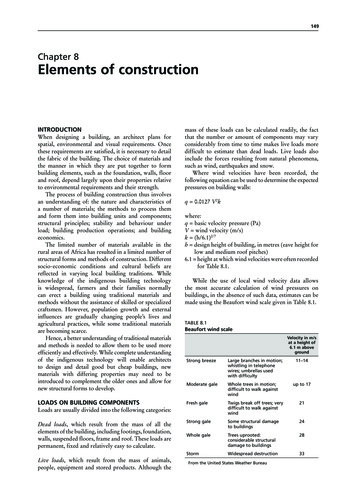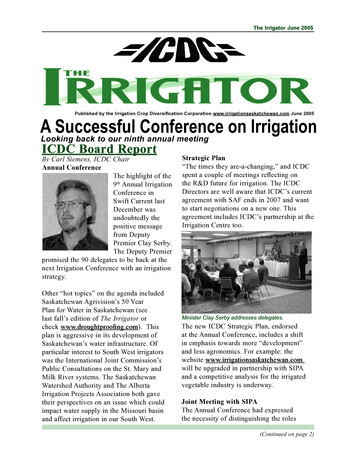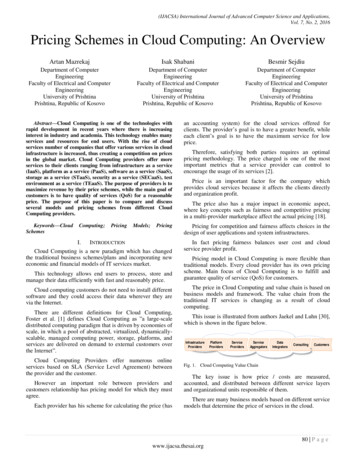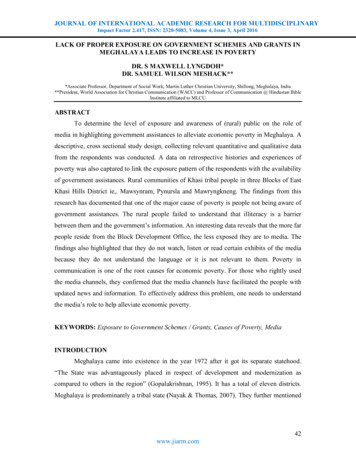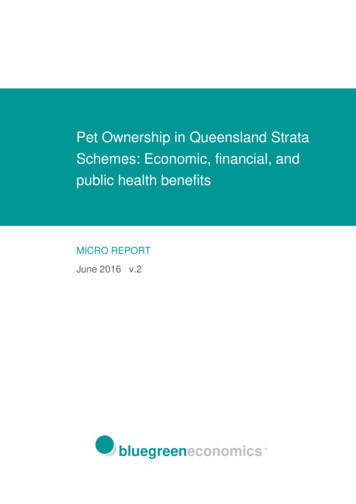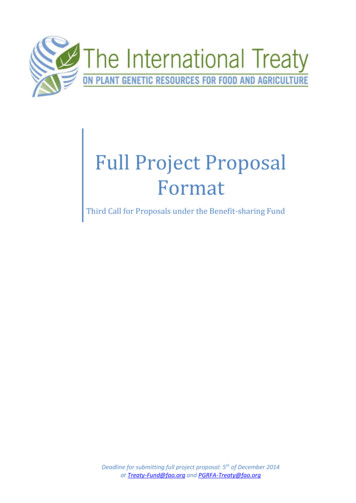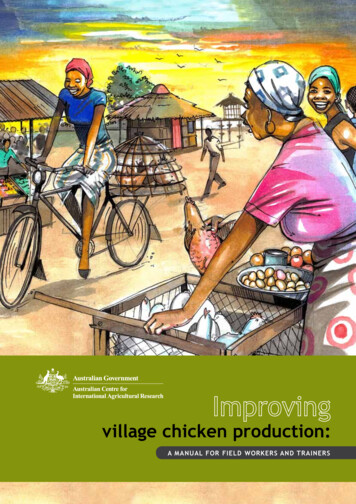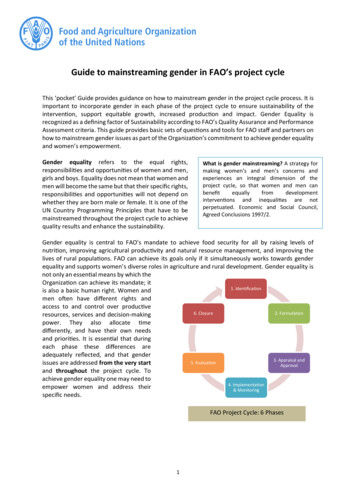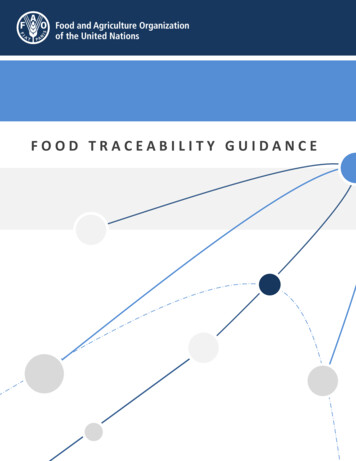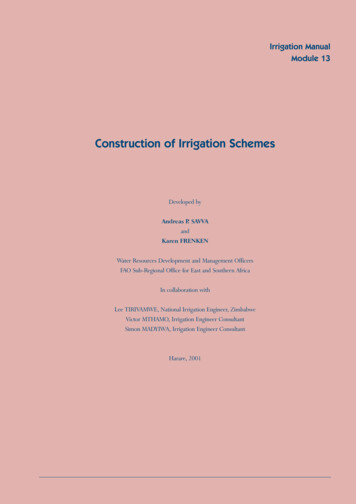
Transcription
Irrigation ManualModule 13Construction of Irrigation SchemesDeveloped byAndreas P. SAVVAandKaren FRENKENWater Resources Development and Management OfficersFAO Sub-Regional Office for East and Southern AfricaIn collaboration withLee TIRIVAMWE, National Irrigation Engineer, ZimbabweVictor MTHAMO, Irrigation Engineer ConsultantSimon MADYIWA, Irrigation Engineer ConsultantHarare, 2001
Irrigation manualii –Module 13
ContentsList of figuresList of tablesList of abbreviationsvvivii1.INTRODUCTION12.CONTRACT MANAGEMENT2.1. Overall project management2.2. Site management2.2.1. Staff management2.2.2. Materials management2.2.3. Equipment management2.2.4. Maximizing profits2.2.5. Settlement of disputes337777883.PROGRAMMING CONSTRUCTION ACTIVITIES3.1. Equipment requirements3.2. Performance of some equipment3.2.1. Bulldozer3.2.2. Scraper3.2.3. Grader3.2.4. Dragline3.2.5. Excavator3.2.6. Front-end loader with backhoe3.2.7. Tipper3.3. Labour requirements3.3.1. Labour for earthworks3.3.2. Labour and equipment for the construction of concrete-lined canals3.3.3. Labour and equipment for the construction of structures3.4. Use of bar chart for programming construction activities910131313151515151516161616174.TYPES AND USE OF CONSTRUCTION MATERIALS4.1. Concrete4.1.1. Important properties of concrete4.1.2. Concrete components4.1.3. Batching4.1.4. Concrete mixtures and mixing4.1.5. Transporting, placing, compacting and curing concrete4.1.6. Steel reinforcement4.1.7. Mass concrete4.2. Gabions and Reno mattresses4.3. Bricks, cement and concrete blocks4.4. Timber4.5. Pipes and fittings4.5.1. Types of pipes and fittings4.5.2. Packing, transporting, storing and handling of pipes and fittings191919192020232323242424252525Module 13 –iii
Irrigation manual5.CONSTRUCTION OF CANALS5.1. Setting out canals5.2. Canal formation5.3. Placing and curing concrete272730316.CONSTRUCTION OF PIPELINES6.1. Trenching and pipe laying6.2. Pipe jointing6.3. Back-filling6.4. Thrust blocks6.5. Pressure testing3333333334347.LAND LEVELLING7.1. Initial levelling7.2. Pegging final levels353535REFERENCESiv –Module 1337
List of 8.19.20.21.22.23.24.Overall employer-contractor roles and responsibilitiesDiagrammatic presentation of employer-contractor lines of communicationCumulative programme progress and resource charts or ‘S’ curvesAn example of a bar chartExamples of different types of equipment used in construction worksWheel-tractor scrapers at work, CAT621G and CAT627GD10R DozerA hydraulic excavatorA motorized grader, CAT120HWheel loader at work, CAT928GArticulated truck or tipper, CAT730Hourly production versus cycle time performance curves for a wheel tractor-scraperTypical performance curves for a wheel tractor-scraperAn example of a gabion basket structureAn example of how AC pipes are stackedA traveler for setting out canalsSetting out a canal using a travelerMetal template for shaping canalsTrapezoidal canal formerFinal cross-section and initial embankment of a canalThe transport programmes for the cut and fill process during canal finalizationTimber shutter frame for concrete slab castinguPVC pipe jointing techniqueIndication of cut and fill in the odule 13 –v
List of tables1.2.3.4.5.6.7.8.vi –Division of responsibilities between contractor and engineerResponsibilities of contract manager and their site agentExcavation quantities for draglinesOutput of manual labour in earthworksBar chart for the construction of a surface irrigation scheme for smallholdersCommon concrete and mortar mixes by volumeConcrete mix proportions by volume batching for different concrete gradesDescription of the various concrete gradesModule 1356151617202122
List of abbreviationsACc/w ratioHPCPESABSuPVCZGCCAsbestos Cementcement/water ratioHeight of Point of CollimationPolyethyleneSouth African Bureau of Standardsunplasticized Polyvinyl ChlorideZimbabwe General Conditions of ContractModule 13 –vii
Irrigation manualviii –Module 13
Chapter 1IntroductionIrrigation projects, like any other project, have a promoterwho is responsible for the provision of funds with which toexecute it. This could be a government, a donor, or in somecases the users themselves, such as a group of farmers oreven an individual farmer. The promoter appoints anengineer to assume the overall engineering responsibilityfor implementing the project on their behalf.The responsibility of the engineer starts with the design ofthe project and extends through the supervision of itsconstruction. The engineer participates in the preparationof the feasibility report of the project, which shows thescope of work and estimated project costs. Once thepromoter and farmers or end users accept the project, theengineer can proceed to prepare tender documents for theexecution of the works (see Module 12). Tenderers submitoffers, showing the cost of and time schedule for theconstruction. The engineer will then make a comparativeanalysis of the tenders and make recommendations to thepromoter. The promoter, also called the client, will thenaccept one of the tenders and sign a contract with theselected tenderer. At this point, the tenderer becomes thecontractor and the client or promoter becomes theemployer of that contractor. Construction activities thenstart.Irrigation projects are capital projects that need to followgeneral contract procedures during their implementation.At the centre of these procedures is the employer-engineercontractor relationship. This relationship defines thecontract management between the parties involved, onewhich is bound by the general conditions of contract (seeModule 12). In order to accomplish the job as per thecontract, the contractor needs an effective projectmanagement system at the organizational level as well as atthe operational level on the site (Chapter 2). Timescheduling or programming of activities for constructionshows how the works should be organized and whatresources mobilized in order to meet the targetedobjectives in the implementation of the project (Chapter3). Finally, this module will look at the way some of themost common construction activities are actually carriedout (Chapters 4-7). In reading these last four chapters, thereader will need to refer to the modules dealing with thedesign of surface, sprinkler and localized irrigation systems(Modules 7, 8 and 9).Module 13 –1
Irrigation manual2–Module 13
Chapter 2Contract managementContract management comprises the management of theconstruction site, its activities and its resources under theagreed conditions of contract.The construction of an irrigation scheme should be viewedas a project in itself. A project is defined as a set of activitiesthat are linked together over a period of time and arecarried out to produce specific goals. Project managementis the planning and the control of the project activities toensure that the goals are achieved in time and within thebudget.Management includes the following three processes:and within the budget. It is therefore important at this stageto define the relationship between the employer, theengineer and the contractor so as to understand how theconstruction project has to be managed (Figure 1). Theroles and responsibilities of these three parties involvedshould be well defined and spelt out in the generalconditions of contract. They may vary from country tocountry but they largely address the same issues.The following definitions help to clarify the role of thedifferent actors in managing a contract:YContract: A contract is a legally binding agreemententered into between the employer and the contractorfor the execution of the works desired by the employer.It is also an expression of the willingness of theemployer to pay the contractor and of the contractor todo the work as per the agreement.YContract documents: Contract documents consistof the following documents: conditions of the contract,specifications, drawings, priced bill of quantities,schedule of timing of works, schedule of rates andprices, the tender and the contract agreement. Signingof the contract agreement is an endorsement that bothparties are happy with the contents of the contractdocuments.YEmployer: The employer, also called the promoter orinitiator of the project, is responsible for providing thefunds for the project.YEngineer: The engineer is the person appointed bythe employer and notified in writing to the contractoras having the overall engineering responsibility for thedesign and supervision of the construction of theproject.YResident engineer: A resident engineer is theengineer’s representative on the site of the works. Theresident engineer discharges the functions of theengineer upon delegation of such powers and authorityby the engineer in writing to the contractor. Otherwise,the duties of the resident engineer are to watch,supervise the works, test and examine materials to beused and the workmanship in connection with theworks. As shown in Figure 2, the engineer may appointpersons to assist the resident engineer. The contractorshould be notified of such persons and their functions.1. Organization: refers to roles, responsibilities andreporting structure2. Planning: refers to resource planning and activityplanning3. Control: refers to control meetings and control pointsThese three processes are a necessary part of projectimplementation. They apply to irrigation projects as muchas they apply to any other civil engineering project and areimportant to both the employer and the contractor.There are two levels of project management:YYthe organizational level, usually at the head office,involving the contractor and the engineer, who isappointed by the employerthe operational level on the site, involving the contractor’s site agent, also called site manager, and theengineer’s representative at the site, also called residentengineerFrom the contractor’s point of view, the contract managerand the site agent are responsible for the management ofthe contract. From the employer’s point of view, theengineers are responsible for managing the contract.Therefore, the management of the contract is a jointresponsibility of the two parties at both projectmanagement levels.2.1. Overall project managementThe contractor has to put in place an effective projectmanagement team in order to execute the project on timeModule 13 –3
Irrigation manualThey do not have power to issue instructions to thecontractor.Contractor: The contractor is a company, firm orindividual who undertakes the execution of the works.From the contractor’s point of view, the contractmanager and the site agent are responsible for themanagement of the contract. The site agent is directlyresponsible for managing the contract on site. Fromthe employer’s point of view, the engineer isresponsible for managing the contract. Therefore, themanagement of the contract is a joint responsibility ofthe two parties at both management levels.YFigure 1Overall employer-contractor roles and responsibilities4–Module 13YProject or contract manager: The project manager,also known/referred to as the contract manager, iseffectively responsible for contract management fromthe contractor’s point of view and provides back-upservices to the site agent. If the employer so wishes,they can also have a project manager.YSite manager or site agent: The site manager, alsoknown as the site agent, is the representative of thecontractor on the site of the works. The agent is a legalrequirement for most contracts. They receiveinstructions from the engineer, which become bindingon the contractor. As far as the contractor is concerned
Module 13: Construction of irrigation schemesthe agent is primarily responsible for the successfulcompletion of the works with due regard to time,workmanship, safety and the cost. The site agent isresponsible for a whole host of activities, chief amongwhich are: planning, organizing, administering,engineering, personnel and plant management, andfinancial control. Site management is in fact themanagement of resources. The resources are known asthe 5 M’s, being: Methods, Men, Machines, Materialsand Money. Besides this, the site agent also has tomanage time. This is the reason why there is a need forthe site engineer to have good resources and activityplans prior to the commencement of constructionwork. This has to be backed up by competent site staffand regular control and progress assessment meetings.The resource and activity plans are obtained by timescheduling for construction, which will be discussedlater.Sub-contractors: The main contractor may decide tosub-contract part of the work to some other specialistfirms. Such firms, not forming part of the contract, areknown as sub-contractors. The engineer shouldapprove the choice of the sub-contractor. The maincontractor controls sub-contractors. The site personnelof the engineer, main contractor and sub-contractorshould be conversant that the aspects of the contractagreement and conditions, which govern theemployment of sub-contractors.YFigures 1 and 2 present the relationships between thedifferent parties involved.Table 1 presents the division of the responsibilities betweenthe contractor and the engineer during the different stagesof the project, while Table 2 presents the responsibilities ofthe contract manager and their site manager.Table 1Division of responsibilities between contractor and engineerCONTRACTORENGINEERHead OfficeArrange insurance, etc.Check and approveAppoint site representativeEnsure employer has advised contractor of the appointmentof the engineerSiteExecution of work:Supervise:–Establish site––Set out works–Check and approve–Site preparation, earthworks, foundations, etc.–Test, check and approve–Execute specified details–Supervise, check and approve–Manage sub-contract work–Supervise, check and approve–Query specifications and drawings–Clarify and issue variation order if necessar
Construction activities then start. Irrigation projects are capital projects that need to follow general contract procedures during their implementation. At the centre of these procedures is the employer-engineer-contractor relationship. This relationship defines the contract management between the parties involved, one which is bound by the general conditions of contract (see Module 12). In .
